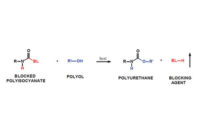Q&A About Polyurethanes
Q: You've previously discussed polyol recommendations for formulating a two-component polyurethane adhesive. Do you have similar recommendations for the isocyanate component?
In many ways, the recommendations for choosing the proper isocyanate parallel those used in choosing the polyol formulating components. The isocyanate content, functionality and viscosity are all important variables that influence performance. In this discussion, the assumption is made that the isocyanates will all be reacted with the same polyol blend to allow valid performance comparisons to be made.The percent isocyanate content is a measure of equivalent weight and thereby the molecular weight of the isocyanate. In general, using an unmodified polyisocyanate with high isocyanate content (e.g., ~ 30% for MDI-based products) will produce a higher modulus polymer compared to using a modified polyisocyanate with lower isocyanate content (e.g., ~15%) and higher molecular weight. The higher molecular weight prepolymer will produce a softer polymer since the base isocyanate has often been modified with a flexible polyether polyol. Modified isocyanate prepolymers also have the advantage of being more compatible with the polyol component, which leads to more efficient mixing.
As mentioned in a previous column (May 2011), the average functionality of the polyol blend and the isocyanate determine the crosslink density of the adhesive. Typical functionalities of isocyanate prepolymers can range from 2-3. A formulation that uses an isocyanate with a high functionality often produces an amorphous polymer that is highly crosslinked and may be hard and brittle. An adhesive of this type would not be able to absorb stresses put on the bond line during use.
The isocyanate content is also important for the practical reason of determining the mix ratio of the adhesive’s isocyanate and polyol components. Various types of mixing equipment are available, but many have a fixed volume/volume mix ratio (typically 1:1 or 2:1). Disposable fixed-ratio mixing systems are available for commercial and DIY applications. Fixed-ratio mixing equipment often forces the adhesive formulator to modify the isocyanate content of the two-component mixture to more closely match the polyol component’s molecular weight. This can be accomplished by blending available polyisocyanates or by manufacturing a unique isocyanate prepolymer. The most flexibility in processing is possible through the use of plural component meter/mix dispensing equipment, which can deliver a range of volume/volume mix ratios. With this equipment, there is no need to artificially restrict formulating options.
Adhesive performance can be negatively impacted by foaming in the bond line as the curing reaction takes place. Formulations using an isocyanate with a low molecular weight and high isocyanate content have a tendency to foam due to the large number of isocyanate groups needed to cure with the polyol before a side reaction with water takes place. The water reaction generates carbon dioxide. Foaming is also influenced by the chemical ratio of isocyanate to polyol groups. Over-indexing with an excess of isocyanate groups does improve the adhesive performance, but foaming can occur in the bond line if over-indexing is excessive.
The viscosity of the isocyanate prepolymer is linked to the isocyanate content. If the adhesive formulation is designed to use an inorganic filler, such as talc, a lower viscosity isocyanate prepolymer has an advantage. The amount of filler used directly impacts the viscosity of the polyisocyanate reactant. Once again, a balance must be achieved between the percent polyisocyanate, the filler level and the viscosity. If the viscosity of the filled prepolymer is too high, the efficiency of the mixing process with the polyol component can be negatively impacted. In previous columns, it was noted that prepolymers containing the 2,4’-isomer of diphenylmethane diisocyanate have a reduced viscosity, but the reactivity of the system is reduced.
Multiple factors relating to the isocyanate component can impact the performance of a structural adhesive. Extensive formulating studies are needed to produce an adhesive with the desired performance.
For additional information on the topics addressed or to ask another question, e-mail jeff.dormish@bayer.com with the subject line “Polyurethane Q&A.”
Any views or opinions expressed in this column are those of the author and do not represent those of Adhesives & Sealants Industry, its staff, Editorial Advisory Board or BNP Media.
Links
Looking for a reprint of this article?
From high-res PDFs to custom plaques, order your copy today!








